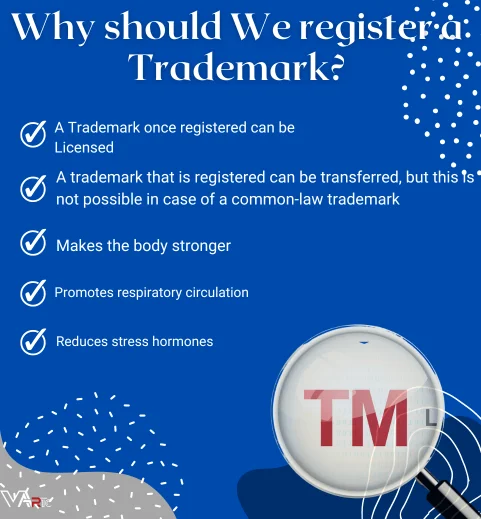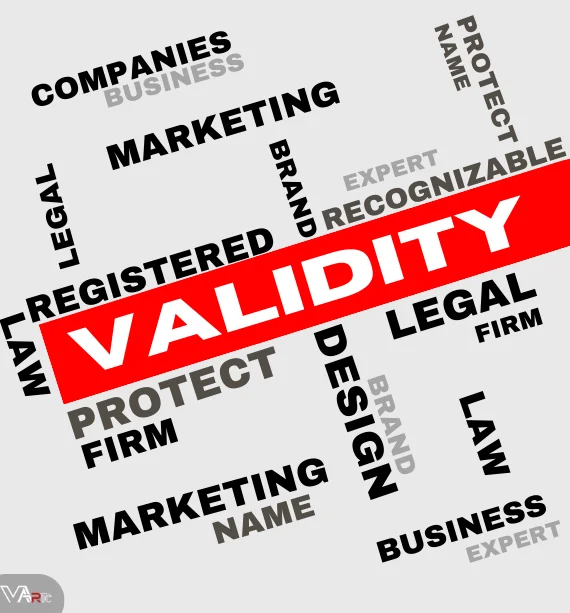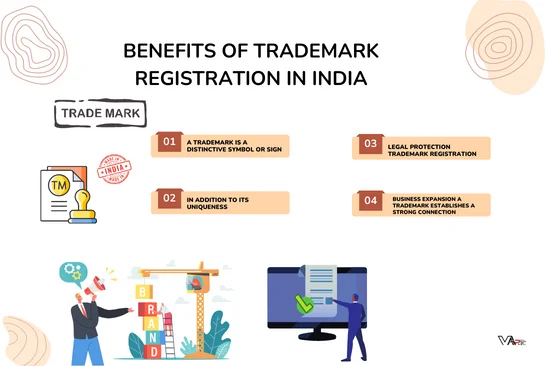Registering the Trademarks
A Trademark refers to any distinctive mark ,such as a Name ,Logo ,Symbol ,Figure ,letter ,or Word ,used by individuals or companies to differentiate their goods or services from those offered by others. It is Essential for a trademark to have the ability to Distinguish one’s goods or Services from those of others. The Trade Marks Act of 1999 Governs and encompasses various aspects related to trademark registration ,the associated procedures ,rectification ,appellate procedures, as well as offenses and penalties.
Trademarks are of a different type:
- Goods / Products Trademarks
- Service Trademarks
- Collective Trademarks
- Certification Trademarks

Why should we register a Trademark?
Trademark registration offers numerous advantages in both legal and business contexts, particularly in the realms of branding and marketing. By registering a trademark, individuals or businesses can reap a range of benefits.
- A Trademark once registered can be Licensed
- A trademark that is registered can be transferred, but this is not possible in case of a common-law trademark, which can only be transferred with the business
- A registered trademark indicates where the products or services were produced.
- A registered trademark guarantees security & quality
- Advertisements for goods and services become easy on registering a trademark
What is the Validity of a Registered Trademark?
After filing a Trademark Application with the Trademark Office ,the applicant gains the ability to use the TM symbol ,indicating their claim to the trademark. If the Trademark is successfully registered ,the Applicant can then utilize the ® symbol alongside their trademark. The Validity of registered trademarks extends for a Period of 10 years from the date of application.
When a trademark approaches the end of its validity ,it can be effortlessly renewed by submitting the Government fee for registration within a period of 6 months. This can be done by completing Form TM-12 (Renewal of Registration) after the expiration date of the trademark.
If a trademark has expired ,it can be Reinstated by Completing Form TM-13 (Restoration & Renewal) within a period of six months up to one year from the date of the last registration of the trademark. This form allows for the restoration and renewal of the Expired Trademark.

Documents Required for Registering Trademark
The list of Papers needed for Trademark registration in India is as follows:
- A duplicate of the chosen logo or trademark. A logo is not necessary for a trademark for words.
- Name ,Nationality ,and Address information for the applicant.
- The certificate of establishment for a business or LLP.
- In the case that the company is eligible for the lower filing fee, it can refer to Udyog Aadhaar Registration.
- A detailed description of Goods or Services represented by the mark.
- A trademark application must specify one of the 45 trademark classes, however several classes (Class 99) of trademark applications may also be filed.
- The applicant must sign the power of attorney in Form TM-48 Format (Form of Authorization of an Agent).
What is the Registration process for a Trademark?
As the initial and crucial step in India’s registration process, it is essential to register a trademark as early as possible, following the “first to file” basis. Typically ,the registration process takes around 4 to 24 months to obtain full registration. Therefore, early registration is recommended to secure the rights to a trademark.
When filling out the trademark application ,it is important to consider the appropriate territorial jurisdiction. Once the application is submitted ,you will typically receive a trademark application number within one or two days. The Office of Industrial Designs, Controller General of Patents, Trade Marks ,and Geographical Indications oversees the processing of trademark applications. Branch offices for these entities are located in Mumbai, Kolkata ,Ahmedabad ,Delhi ,and Chennai.
The registration process of the Trademark takes the below mentioned steps:
Step 1:
Extensive Search for Trademark prior usage and existence:
The initial and crucial step in the trademark registration process is conducting a trademark search. Each application has distinct registrations that align with the interests and work of individuals. Performing a thorough search, particularly on the intellectual property website, is a recommended starting point. This search helps identify any similar marks by exploring various combinations. If any matching marks are discovered, a detailed review is conducted to assess whether they pertain to the same set of goods or services as proposed in your application.
Step 2:
Document preparation for the trademark Application:
After completing the trademark search, the next step involves preparing a trademark application with essential applicant details such as Name, Address, E-mail, etc. Additionally, the application includes information regarding the trademark class, description, and device logo. A Trade Mark Attorney reviews these details and ensures their accuracy before filing the trademark application. Once all the necessary supporting documents are in order, the applicant proceeds to sign Form 48 (Agent Authorization) and TM-1 (Application for Registration).
Step 3:
Online filing of the Application:
The Trade Mark Registry must receive a fully completed trademark application. Additionally, the government charge for trademark registration is specified and varies depending on the applicant type. The government charge is Rs. 4500 for individuals, small businesses, and enterprises. For all other candidates, the fee is Rs. 9000. For the attorney professional, there is a distinct fee structure in place, and each application costs Rs. 3500.
Step 4:
Processing done by the Registrar:
Once the trademark application is filed ,the processing of the application commences. It is Important to regularly check the status of the application as it Progresses through the registry's Procedures. To stay updated ,one can conveniently check the application status on the registry's website by searching using the trademark application number. Additionally ,E-mail notifications are also sent to the attorney's provided email address during the filing process.
Step 5:
Objections raised by Registrar:
Trademark applications can be Rejected based on Absolute Grounds (as per section 9 of the Trademarks Act ,1999) or Relative grounds (as per Section 11 of the Trademarks Act ,1999). If any Objections are raised Concerning the filed trademark application ,the Applicant is required to Submit a response to address the objections within a 30-day timeframe.
Step 6:
Acceptance and Advertisement in Trademark Journal:
Once a Trademark application successfully Clears all Checks by the registrar and meets the Necessary requirements ,it is published in the trademark journal for advertisement.
Step 7:
Opposition by Parties:
After a trademark is published in the trademark journal, it becomes susceptible to opposition from parties affected by its registration. Interested parties can oppose the trademark by submitting Form TM-5 (Notice of Opposition). In the event of a notice of opposition, the trademark applicant is required to respond within the given time period using Form TM-6, addressing the concerns raised by the opposing party.
Cost for Trademark Registration in India
The Cost for Trademark Filing in India is ——/- in case of Individual/ Startup/ Small Enterprise and ——/- in all other cases.
| Official Fees (INR) | Professional (INR) | Total |
Trademark Application(Charges are for per class per mark application) | ₹ ——/- in case of Individual/ Small Enterprise | ——/- | —–/- in case of Individual/ Startup/ Small Enterprise |
——/- in all other cases | ——/- in all other cases | ||
In case of any objection from the Trademark Registry a reply to the Trademark Registry | – | ——/- per reply | ——-/- per reply |
In case of a hearing to overcome the objection | – | ——/- per hearing | ——/- per hearing |
After a trademark is accepted and published in the official journal, it becomes susceptible to opposition from third parties for a period of four months. If an opposition is raised, it will initiate a separate procedure that may incur additional charges based on the specifics of the case.
In case the applicant is a start-up having a DIPP certificate, professional charges will not be applicable but the official fees will be INR ——/-.
Benefits of Trademark Registration in India
- A trademark is a distinctive Symbol or sign ,such as a label ,numeral ,or Combination of colors ,used to identify your goods or services. To protect your trademark ,you can apply for registration under the Trademarks Act ,1999.
- A Trademark serves as a means to Differentiate your products and services from those offered by your competitors. However ,it is Important to note that geographical names ,common names ,common trade words ,and Common abbreviations cannot be registered as trademarks.
- In addition to its uniqueness ,a trademark should be user-friendly ,enhance the marketability of your products ,and establish brand recognition. Registering a trademark offers numerous advantages and benefits to the owner.
- Legal protection Trademark registration grants intellectual property protection, safeguarding the trademark from infringement. It also provides the owner with an exclusive right to use the trademark in relation to the specific “Class” of goods or services it represents. Once the trademark application is filed, the “TM” symbol can be used with the products. The use of the “R” symbol is only permissible after obtaining trademark registration. It is important to note that the ® symbol can only be used for the goods and/or services listed in the registration certificate. In case of unauthorized use of a registered trademark, the owner has the right to seek relief for infringement through appropriate courts within the country.
- Product differentiation Trademark registrations are specific to the goods or services they represent. By obtaining a trademark ,you can differentiate your products from those of your competitors. The registration ,valid for the entire class of goods or services it represents, facilitates clear identification of your products. This distinct identification helps customers uniquely associate and identify products bearing different trademarks, which in turn helps you build a loyal customer base for your product.
- Business expansion a trademark establishes a strong connection between customers and the products offered by an enterprise. By providing efficient or unique products ,you can successfully build a loyal customer base. Your trademark plays a crucial role in retaining and expanding this customer base. The registration of your trademark grants you exclusive rights to use it for a period of 10 years ,safeguarding your business revenues. Business enterprises can leverage the benefits of a loyal customer base by introducing new products and expanding their operations.

- Brand recognition Customers often associate a company’s products with their performance ,quality ,features ,and more. This association is commonly attributed to the logo, which serves as a registered trademark. Registering a trademark enables brand recognition for your goods and services, establishing a positive reputation and goodwill for your brand. As a result, your brand becomes recognized and gains market value over time. The recognition of your brand not only attracts new customers but also fosters loyalty among existing ones.
- Creation of an asset Trademark registration serves as an asset for a business enterprise. From an accounting and income tax standpoint, trademarks are recognized as intangible assets. As intellectual property, trademarks hold value attributed to the products they represent. They can be sold, franchised, assigned, or commercially exploited in various ways. The value or cost associated with trademarks can be acknowledged in the books of accounts, allowing for depreciation deductions and recognizing income derived from them.
- Business valuation and goodwill Registering trademarks and linking them to your products significantly enhances the overall value ,goodwill ,and net worth of your business within the industry. Your trademark serves as a means to convey Quality assurance ,highlight distinctive features of your products ,and reflect your organization’s mission. Trademarks play a vital role in driving the Growth of your business. They not only help in retaining loyal customers but also safeguard the goodwill associated with your business.
- Trademark recognition a Trademark registered in India remains valid for a period of ten years from the date of filing the application. However ,it can be renewed thereafter. If you plan to utilize your trademark outside of India or expand your business internationally ,you will need to obtain trademark registration or approval in the respective countries. In such instances ,your existing trademark registration and business in India serve as a foundation for obtaining registrations in foreign jurisdictions.
Infringement of Trade Mark:
Infringement is a breach or violation of another’s right.
Infringement ,as defined by Black’s Law Dictionary ,refers to an act that Interferes with the exclusive rights of a patent ,Copyright ,or Trademark owner. According to the Trademark Act ,a Registered Trademark is Considered Infringed if an Individual uses it as their trade Name ,a part of their trade name ,the name of their Business Concern ,or a part of their business Concern in Connection with goods or services that the trademark is Registered for. Infringement of a Trademark occurs when someone other than the registered owner uses such a mark.

According to Trademark Act, a mark will be regarded to be Infringed Mark if:
- The whole registered mark is found to be a duplication with some additions and modifications,
- The allegedly infringing mark is used in commerce,
- The infringing mark is being used in written form or in its typical form in advertisements. Any oral utilization of the trademark isn’t infringement.
- The mark utilized by the other individual which almost looks like the characteristic of the registered owner as is probably going to deceive or cause confusion and in relation to goods in respect of which it is registered.

Protection Against Infringement of Trade Mark:
According to Section 29 of the Trademark Act ,1999 ,the Unauthorized use of a trademark by an Individual who is not the registered Owner or a registered licensee ,If the trademark is identical or Deceptively Similar to a registered trademark ,constitutes trademark Infringement. In such Cases ,the Registered Owner has the right to take Legal Action and seek remedies for the Infringement of their trademark.
In an infringement case, the Supreme Court has established that if two marks are identical ,then infringement is established. However ,if the marks are not identical ,the Court must assess the degree of resemblance in terms of phonetic ,visual ,or conceptual aspects as perceived by the registered owner. Even if the essential features of the registered proprietor’s mark are used by another person, the Court may still make a determination based on these factors.

In an action for Infringement of Trademark:
- The offended party must be the registered proprietor of a trademark
- The Response must use a mark that is Confusingly similar to the mark of the party that complained.
- The items for which the offended party’s trademarks are registered must relate toA the usage,
- The Defendant’s use of them in the Course of Business must not have been Unintentional.
Differences Between Passing Off and Infringement
- The Action for Passing off Differs from an Infringement action as it is a Common law remedy rather than a statutory remedy. To establish infringement of a registered trademark ,it is Sufficient to demonstrate that the infringing mark is identical or deceptively similar to the registered mark ,without the need for additional evidence.
- In a passing off action, it is not sufficient to merely Demonstrate that the marks are Identical or deceptively similar. It is also Necessary to establish that the use of the mark is likely to cause Confusion or Deception.
- It is Crucial to Demonstrate that the Defendant’s Use of the Trademark is likely to Cause harm or Damage to the plaintiff’s Goodwill. However ,in an infringement suit ,the Use of the marks by the defendant does not necessarily need to cause any harm to the plaintiff. It is important to note that when a Trademark is registered ,the Registration is granted only for a Specific Category of goods.
- Protection is granted specifically to the goods for which the trademark is registered. In a passing off action ,it is not necessary for the defendant’s goods to be identical; they can be related or even different.
Satyam Infoway Ltd. Vs Sifynet Solutions (P) Ltd.
In Satyam Infoway Ltd. Vs Sifynet Solutions (P) Ltd. According to the Court’s ruling in 2004 (6) SCC 145 ,three factors must be taken into account in order to prove passing off. They are as follows:
- The first element in an action for Passing off, the term passing off itself alludes, is to restrain the defendant from passing off its goods and services to the public as that of the plaintiff’s. It is an action to also safeguard the public but not only preserve the reputation of the plaintiff. The defendant should sell its goods and offer its services in a manner as laid down or as perceived to the public into thinking that the defendant’s goods or services are for the plaintiffs.
- The term “passing off” in an action for Passing off refers to Preventing the Defendant from Misrepresenting its Goods and Services to the Public as those of the Plaintiff. This Action Aims to Protect not only the Reputation of the Plaintiff but also the interests of the Public. The defendant should refrain from Selling goods or Offering services in a manner that could mislead the Public into Believing that they are Associated with or Endorsed by the Plaintiff.
- The third component of a passing off action is loss or its probability.

It is Important to be aware that in such cases ,another party can legally Acquire your trademark by Applying for Registration ,even If you were the first to use the trademark. This means that someone else can obtain the rights to your Trademark by Submitting a registration Application before you do.
Trademark Registration under the Act
Trademark registration under the Act only provides protection within India. To obtain trademark rights and protection in other countries ,it is necessary to use and register the Trademark in those Specific countries. It’s important to note that trademark Protection is regional ,Meaning it is limited to the specific region or country where it is registered.
To obtain protection in different countries, a separate trademark registration must be obtained in each desired nation. If protection outside of India is desired, it is necessary to file trademark applications individually in the respective countries.
It is important to note that in certain countries like Continental Europe ,China ,Japan ,and Indonesia ,the rights to a trademark are granted to the first person who applies for Registration ,rather than the individual who first uses the trademark. Therefore ,it is Crucial to Apply for trademark Registration in a country before commencing use of the trademark in that specific country.
Frequently Asked Questions:
Ans- The Trademark Registry has categorized goods and services into 45 classes. Each class encompasses a range of specific goods or services, and it is important to mention the relevant class(es) on your trademark application based on what you are offering. Your trademark will be registered and protected specifically under those designated classes.
A- In case your trademark bears resemblance to an existing application, contains geographical names, common words, or may hurt religious sentiments, it may be rejected. Additionally, if your trademark is likely to cause confusion, it may also face rejection.
A- Upon filing the trademark application and receiving an acknowledgment ,you can start using the ™ symbol to indicate your claim to the trademark. After the registration process is successfully completed ,you are then authorized to use the ® symbol with your trademark.
A-Conducting a basic trademark search can be done easily through trademark search tools. However, for those genuinely interested in registering their trademark, it is highly recommended to seek professional assistance for comprehensive trademark research.
A-If your Brand name has Already been Registered under a different Class ,there is still a chance for your application to be approved ,unless the brand is Widely recognized ,such as McDonald's or Fiat.
A- If the word you desired is unavailable for trademark registration ,there is still hope. Instead ,you can create a distinctive logo for your business and incorporate the name within it. While there is a solution ,it is advisable to choose a unique name from the outset.
A- Start-up founders often Register trademarks in their personal names ,whereas larger businesses prefer to register them in the name of the company. This distinction arises from the uncertainty surrounding the future of a start-up. When a trademark is owned by the founder ,it remains valid regardless of the company's status. However ,in such cases ,a trademark license agreement is required to establish the rights and permissions associated with the trademark.
A- The approval process for a trademark can range from 6 months to 1 year. However, it is possible to apply for a trademark and begin using the ™ symbol within a few days, provided all necessary details and documents are promptly submitted.
